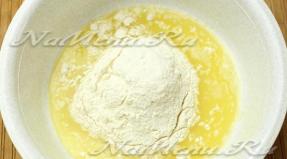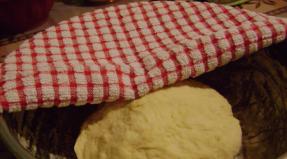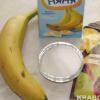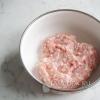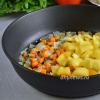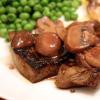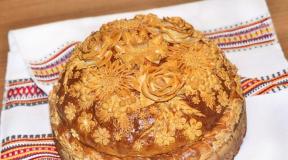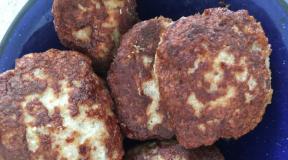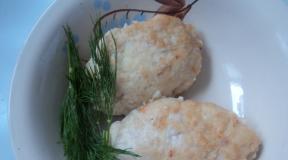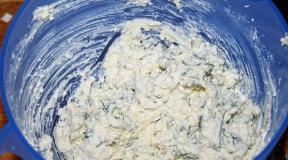Balanced meals for schoolchildren menu. School meals
The student's menu should not only be tasty and varied, but also healthy. Dishes for school meals will help the body of a child and adolescent to receive all the necessary trace elements.
Below is a sample menu for a school cafeteria for a week.
Children should eat porridge for breakfast. Its benefits are beyond doubt. Porridge with vegetables is even more useful. The main thing is to cook it correctly. For this dish, you can use ready-made pumpkin puree or fresh pumpkin. The fruit is cleansed, freed from seeds. The pulp is cut into pieces and stewed for half an hour.
Usually, ready-made raw materials are delivered to canteens in the form of mashed potatoes, which are added to the porridge at the end of cooking. In this case, the cereal is boiled first. There is one important nuance here. So that the cereal does not taste bitter, the sorted and washed millet is poured with boiling water. It is kept in this form for 5 minutes, and then the water is drained. Now the cereals can be boiled.
The grain is poured with water in a ratio of 1: 3 and the cereals are boiled, stirring, over low heat for 30-40 minutes. Then you need to salt, add sugar. Pumpkin puree is added 5 minutes before the end of cooking. If the dish is cooked from pieces of pumpkin, then after they have been cooked, the vegetable is chopped. The cook put the porridge on the plates, poured over it with preheated butter. One serving is 150-200 grams of porridge.
It is served with a cereal coffee drink with milk, enriched with micronutrients - 200 grams; 100 grams of fruit yogurt; crispbreads and fresh fruits or berries.
Schoolchildren will start their lunch this day with a vegetable vinaigrette. School canteen meals made for lunch are tasty and healthy too. In order to prepare this dish, vegetables are thoroughly washed: potatoes, beets, carrots. They are boiled in the "uniform".
Potatoes are cooked with carrots, and beets are cooked in a separate bowl for a longer time. To keep it soft, after the end of cooking, it is placed in cold water. Vegetables are peeled, cut into cubes, green peas are added, salted and seasoned with sunflower oil.

The first course is a broth soup with pasta. Children love pasta. Therefore, such a dish will be eaten with pleasure. First, boil the meat, remove the foam or drain the first broth. Carrots and onions are sautéed separately. Chopped potatoes are added to the broth and cooked for 10 minutes. Then the pasta is poured. You can cook soup without potatoes, then the amount of pasta increases.
For three times meat goulash with mashed potatoes is served. You can also make a complex side dish by adding cauliflower to the potatoes. These vegetables are boiled and then wiped. Warm milk is poured into them, salt and butter are added.
Before boiling cauliflower, it is disassembled into inflorescences and placed in already boiling water. This will save more vitamins in the vegetable. Reduce heat and close lid. It will also help preserve more vitamins. Better to boil vegetables in salted water.
For lunch, special wheat and rye-wheat bread is served, enriched with micronutrients, minerals and vitamins. Kissel is delivered to the canteen in the form of an industrially produced concentrate. Jelly is quickly cooked from such raw materials.
The concentrate is diluted in a small amount of water. This solution, stirring, is poured into boiling water, brought to a boil, and the jelly is ready. For dessert, cast semi-hard toffee enriched with micronutrients is suitable.
The second day includes the following collection of recipes for school meals:
Breakfast - boiled sausages for school meals (49 grams) with stewed cabbage (100 grams). These two dishes go well together. Raw cabbage is chopped, lightly fried with chopped onions and carrots, then a little hot water is added and stewed with the lid closed. Towards the end of cooking, add salt and tomato paste.
Children will also like floral herbal tea (200 grams). Sugar is given in individual packaging in the amount of 10 grams. Bread from wheat flour of the first grade is put on one person 20 grams. For dessert - pressed muesli - a bar, plus fresh berries or fruits.

Lunch starts with a salad of carrots and prunes. The prunes are pre-washed and soaked for 30 minutes. Now you can chop it finely, grate the carrots and season everything with salad sauce.
The first dish is pea puree soup. Peas also need to be soaked in advance. You can do this in the morning or in the evening. Boil peas, stirring, for a sufficient time, then add smoked meats and boil more. 25 minutes before the end of cooking, add chopped potatoes and roast carrots and onions. Wheat bread croutons will be very good for such a soup. Usually some bread remains. Cooks cut it into squares and dry it on a baking sheet.
The second is served with stewed fish fillet with a complex side dish, which consists of boiled rice and seaweed. Rye-wheat bread with minerals and vitamins. The fortified apple compote completes the school feast. The nutrition of school-age children should include everything they need, including vitamins. In the presented dishes, they are contained in sufficient quantities.
The third day
Wednesday starts with breakfast. It consists of a tomato salad with vegetable oil. In addition to the appetizer, the main course is also prepared. These are minced chicken cutlets with pasta of group A. Minced chicken - ready-made, industrial production. It has already been rolled through a special meat grinder at least twice and has a uniform consistency.
To it are added chopped onions, eggs and the crumb of white wheat bread soaked in water. Everything is thoroughly mixed and breaded in breadcrumbs. Cutlets are placed on a baking sheet and sent to stew in the oven. School canteens can buy ready-made semi-finished meat products from factories that produce food for children. Then the frozen product will need to be kept at room temperature, after it has thawed - sent to the oven.
Drinking is also required for breakfast. An instant cocoa drink with milk, enriched with micronutrients in the amount of 200 grams, is perfect for this. Fresh berries, fruits and 20 grams of fortified wheat bread are also relied on here.
For lunch, the chefs will make a cucumber salad with vegetable oil or sour cream. The first dish is Siberian borscht in meat broth. Children will also like the second course. This is a potato casserole with boiled meat. Potatoes can be boiled in their skins and chopped.
Then you need to add eggs and mix the mass well. The meat for the casserole is pre-boiled. The first course is made in this broth. Meat is taken in such a quantity that it would be enough for both the first and the second. For the first, it is cut into pieces and placed in each plate when serving.

Dessert - fortified compote from quick-frozen currants and pressed muesli in the form of a bar. The bread for dinner is the same as in the past.
Fourth day
School meals for this day are also delicious, healthy and varied.
The day begins with a curd casserole with berry sauce. Milk is also served for breakfast with a straw, individually wrapped.
Lunch consists of a salad of boiled beets and fresh apples with vegetable oil. The first course is cauliflower soup flavored with sour cream. The second is Stronogov's liver with boiled pasta. Compote is cooked from dried apricots.
The fifth day
Breakfast: Fish casserole from ready-made fish fillets for school meals with mashed potatoes. A cucumber canned without vinegar is also supposed to be included here. The drink is tea with lemon and sugar. Dessert - fortified biscuits.
Lunch is rich in protein. It consists of salad. Boiled or canned beans are mixed with grated cheese and seasoned with sour cream. The first dish is Leningrad pickle in poultry broth. The second consists of turkey fillet stewed in tomato sauce and crumbly buckwheat porridge. The lunch is completed with multifruit juice.
Sixth day
Breakfast: Pasta baked with cheese. Fruit bioyogurt, fresh berries or fruits, coffee drink with chicory milk.
Lunch: Commercial marrow caviar for baby food. Potato soup in meat broth with beans. Cod fish meatballs with mashed potatoes. Frozen strawberry compote, muesli bar.

Seventh day
Breakfast: Cottage cheese pancakes with condensed milk, instant cocoa, plus fresh fruits or berries.
Lunch: Salad of apples, carrots with the addition of orange. Fruits and vegetables are seasoned with salad dressing. Peasant soup with millet. Home-style roast potatoes and beef. Hematogen.
Eighth day
Breakfast: Tomato salad, steamed minced meat meatballs, boiled rice. Herbal tea with sugar.
Lunch: Salad of green peas, beets with vegetable oil. Rostov ear. Children's dumplings. Compote of dried fruits.
Ninth day
Breakfast: Bun, muesli with milk, chicory milk drink.
Lunch: White cabbage salad, chicken broth soup with pasta, boiled chicken soufflé. Vegetable stew, apple juice for baby food.
Tenth day
Breakfast: School pizza, instant cocoa, fruit.
Lunch: Vegetable salad with apple, cabbage soup with meat broth from fresh cabbage, crumbly buckwheat porridge, basics from boiled meat, frozen cherry compote.
There are many dishes for baby food. Parents who have taken this menu as a basis will feed their children with healthy and very tasty food. Students will receive everything they need and will be able to study well.
Many parents are concerned about what their child eats and this is right, because a schoolchild's nutrition is a very important component in his development. Food and drink contain essential vitamins and nutrients for growth, body development and mental alertness throughout the day, especially in class. For a child to receive the right amount of nutrients, a healthy and balanced menu is needed.
Schoolboy's menu for the week
Monday (start healthy menu)
- Breakfast - any porridge, bread and butter, tea with lemon or cocoa is recommended.
- Lunch - the student happily eats borscht with bread, vegetable salad, chicken or meat cutlets with potatoes or noodles, then drinks a compote.
- Afternoon snack (snack) - eat any fruit (apple, pear) or kefir with cookies.
- Dinner - it is desirable to make it light and 2 hours before bedtime. Milk with bread, cottage cheese casserole and vegetables.
Tuesday (continuing the healthy menu)
- Breakfast - oatmeal, green tea, bread and butter and a couple of fried eggs will be appropriate.
- Lunch - potato casserole with vegetable salad, cabbage soup, jelly with bread will do.
Snack (afternoon snack) - a bun with milk. - Dinner - some favorite salad, fish and pasta, green or black tea, bread.
- Breakfast - a sandwich with cheese and butter, buckwheat or rice porridge, black tea.
- Lunch - the child will be happy to eat soup with meat broth, vegetable salad, mashed potatoes with cutlets, tea with sugar and lemon to taste, black bread.
- Afternoon snack - 1 fruit (apple, pear, banana), drink 1.5% fat yogurt with cookies or a bun.
- Dinner - Boil rice or buckwheat with meat gravy, vegetables, bread and tea.
Thursday (we continue the healthy menu for every day)
- Breakfast - in the morning it is useful to eat porridge, if the child loves coffee, then with milk and a sandwich.
- Lunch - Mashed potatoes with chicken or meat, vegetable salad, your choice of your favorite soup, orange or apple juice and black bread.
- Snack - 2 pieces of boiled eggs, fermented baked baked milk.
- Dinner - noodles with meatballs and tomato sauce, fresh cucumbers or tomatoes with a bite and bread with tea.
- Breakfast - milk porridge or noodles, coffee with milk, butter sandwich.
- Lunch - buckwheat with fried fish, fresh vegetable salad, compote or juice, bread of your choice.
- Afternoon snack (snack) - a couple of vegetables or fruits.
- Dinner - cottage cheese casserole, salad, tea, bread.
Saturday (the sixth day of the healthy menu has arrived)
- Breakfast - pearl barley or oatmeal, 1-2 eggs, tea with lemon, bread and butter.
- Lunch - the student will appreciate vegetable salad, meat with cabbage, borscht, tea and bread.
- Afternoon snack - tea or milk with a bun or muffin.
- Dinner - Fish, low fat cottage cheese with 10% sour cream, tea and black bread.
Sunday
- Breakfast - buckwheat or millet, green or black tea with or without lemon, bun with cheese.
- Lunch - the child will be delighted with soup with meatballs, boiled chicken fillet, salad and tea.
- Snack - fermented baked milk, kefir, delicious bun and 1 fruit (apple or pear).
- Dinner - cottage cheese with sour cream 10%, chicken fillet, tea or juice and bread.

- A teenager's diet should contain fruits and vegetables every day, because they contain useful vitamins and minerals.
- It is necessary to drink enough water, especially if the child plays sports or leads an active lifestyle, often plays football, rides a bicycle or ski, etc.
- Dairy products contain calcium, which is essential for bone growth.
- Vegetable fats should also be present in the daily diet, as they are beneficial for hair and nails. And animal fats should be minimized in the daily diet.
- Protein is also essential, because it is a builder for muscle mass and recovery of the body, after exertion throughout the day.
Parents should take care of the diet of schoolchildren, because their mood, well-being and school performance will depend on this. Correct the nutritional menu, and let your children be strong and healthy with good school performance.
Harmful Foods - Eliminate Them Today
- Sausages are probably the favorite food of schoolchildren. Sausages are bad enough. Often people use them with pasta or omelet, but you need to get rid of this habit and replace with chicken cutlets or chicken fillets. Moreover, in cheap sausages - there is no meat, and almost half of them consist of fats, soy protein. Sister of sausages, this is a cheap sausage that must be eliminated from the diet of children and adults. Give preference to natural meat.
- Croutons are of no nutritional value. A large amount of salt, and a lot of it is also not good to eat, you understand. And crackers are ordinary bread that has been dried and various ingredients have been added to make it taste. We also exclude them from our healthy diet.
- Sweet drinks, especially carbonated ones - sodium benzoate is present in the composition and these guys, as you understand, are bad. They usually contain a lot of sugar and it is difficult for the body to cope with that amount of glucose. We exclude dietary analogues, since they are no better, but only harm the internal organs.
- Chewing gum - love to chew? It's time to get out of the habit and now you will find out exactly why. After all, this is a harmful product, like fast food (fast food) and breakfast cereals. Flavor modifiers, stabilizers, colorants, etc. All this is contained in the gum.
- Chips - made from potato powder, they are full of fat and all other harmful substances, including salt and solid food additives. Thus, you spend money on them and get a taste sensation, but at the same time harm your health, especially with the daily consumption of chips. So what are we doing? That's right, stop eating chips.
A student's health and academic performance primarily depend on proper nutrition of a schoolchild. He just needs good immunity to protect himself from various infections that are present in large groups. The disease does not just take away strength for a while, it also knocks the child out of the school curriculum and he may begin to lag behind his classmates, not to mention the fact that this adds hassle and worries to the parents.
By taking care of the proper nutrition of our young schoolchild, we significantly reduce the risk of various diseases and lay the foundation for the correct growth and development of the child's body, which will lead to good, robust health in future adulthood. Naturally, food should be varied, tasty, nutritious, and it should be in moderation. The child must be fed at least once every 4 hours, otherwise bile stagnation occurs, which in turn leads to the formation of stones in the gallbladder, and it is advisable to additionally give the child natural vitamins at least three times a year. Let's take a closer look at what to feed a child with and how to make the right menu.
Schoolboy's menu for the day
It all starts with breakfast
Breakfast is the most important meal of the day. Very often people do not want to eat in the morning. In order for the child to develop an appetite in the morning, it is best not to start feeding him until he finally wakes up. Morning exercises are very helpful in this. It may take 30-40 minutes to wake up, so waking up early is a good idea. Breakfast should be complete and provide enough energy for 3-4 hours.
It can consist of all kinds of cereals, mashed potatoes, pasta or noodles. It is also very useful for 20 min. give the child fruits or berries before the main course. This will additionally warm up the appetite and have a positive effect on the motility of the gastrointestinal tract, not to mention the vitamins, enzymes and other useful components contained in the fruits. You can drink breakfast with natural juice, tea, compote, cocoa or coffee with milk.
Lunch
If the school feeds in the canteen, then an additional bag of food is simply not required. Of course, it is necessary to take a closer look at the food served within the school walls, and in case of its poor quality and unnaturalness, you should simply refuse such food. After all, we wish only the best for our child. If the food is good in the dining room, then the question of the child's second breakfast disappears.
In the case of poor nutrition, we simply have to start preparing a snack for the child. This may include:
- Natural freshly squeezed juice... Never give your child juice sold in packs. Natural juices are simply not sold now, but what is sold under the name "natural juice or nectar" is simply poison for the body of not only a baby, but also an adult.
- Fruit... Great snack for a child. After all, they contain a large amount of vitamins, micro- and macroelements, enzymes, bioflavonoids and other useful substances. They contain the same fiber that is of great benefit to the gastrointestinal tract, which is so lacking in the diet of the vast majority of people.
- Cookies... Take a closer look at those types of cookies that are not only tasty, but also harmless when consumed. To do this, carefully read the composition on the package. And the best option would be, of course, cookies made at home, with your own hands, then you will know exactly what you put there.
- Water... Be sure to give your child regular drinking non-carbonated water. A child, like an adult, needs water to drink, and no juice, tea or other drink can replace it. How much water does your child need to drink per day? It is very easy to calculate 30 ml × 1 kg of body weight.
Dinner
At lunchtime, the child needs to receive the first, second and dessert.
- First... This may include a small amount of meat, fish or vegetable soup, borscht, hodgepodge, cabbage soup or other liquid hot dishes.
- Second... Any side dish with the addition of boiled or stewed meat or fish and stewed vegetables is suitable here.
- Dessert... Dessert can include any sweetness you like.
Afternoon snack
It is advisable to have a small snack between lunch and dinner. The child can be given:
- Yogurt with cookies.
- Fresh fruits.
- Tea with a sandwich (bread, butter, cheese).
- Milk with a bun.
Dinner
In the evening, feed your baby lightly, do not overeat. It is advisable to have dinner at least 2 hours before bedtime. What can you offer your child:
- Scrambled eggs or scrambled eggs.
- Cottage cheese.
- Vegetable stew.
- Buckwheat, rice or oatmeal.
- Stewed fish.
What should be excluded from the diet of a young student
First of all, factory food should be excluded or minimized from the child's diet. If you do buy such products, then be sure to read the composition before buying. After all, only you are still responsible for the health of the child.
The nutrition of younger schoolchildren determines their predisposition to diseases and, in general, success for many years to come. This factor is designated by doctors as decisive in the formation of a child's body.
In general, at the age of 8, boys and girls already eat not some special dishes, but those that their parents cook for the whole family. The digestive system by this age is considered already formed, plus the presence of teeth. This allows adult food to be eaten.
A correct routine lays discipline in an 8-year-old student regarding the regularity of meals. It is at this age that important skills for life are formed. If successful, you will not have to follow a diet in the future, and the weight will always be normal.
Your child should learn the basic rules for himself:
- eat up at night - live in the future on a diet;
- crackers, crackers and chips cannot be considered a full-fledged food, these are bad, unhealthy foods;
- meals should be regular.
Eating discipline promotes efficient absorption of nutrients from a variety of foods. It is important to start a reflex algorithm for the activity of the children's digestive system by the clock.
Parents should learn the basic principles of healthy eating for their children.
The daily menu of a primary school student should be divided into at least 4 meals. Too large gaps should not be allowed between each of them, otherwise the risk of a sharp deterioration in health increases. This is especially true for eight-year-olds leading an active lifestyle, and those who attend a lot of extracurricular activities.
For example, a young hockey player who spends a lot of energy on training needs more food than a girl who draws. For young athletes, there are special diets that are recommended to be followed.
Making a menu
Children's diet should be thoughtful. Fats are required - in the form of sour cream, butter, meat. Separately, it should be said about fish, because it is rich in essential fatty acids, which have an excellent effect on brain activity.
The amount of protein entering the body with food for children of the indicated age should be about 60% of the total amount of food per day, but no more. Protein is found in dairy products, eggs, cheese, cottage cheese, beef and other animal products. At the age of 8, the child's milk teeth change to molars, so chewing pieces of meat is not difficult for him.
The volume of carbohydrate consumption per day for a schoolchild is at least 300-400 g.
When a child at school learns new material, and this happens all the time, the load on his eyes increases. Therefore, the menu must include carrots, tomatoes, kiwi, apricots, citrus fruits and fish oil. You can pamper and.
Salty, smoked and canned foods should be strictly dosed, the same goes for sweets. Instead of bars and cookies, it is better to give your child fruit for a snack at school. Despite the obviousness of this advice, many parents allow their child gastronomic liberties, without thinking about the consequences.
Hourly mode
If your son or daughter is engaged in extracurricular activities, for example, goes to a sports section or a music club, you need to provide for a snack for him - this can be a bag of juice and fruit.
The daily energy value for an eight-year-old student should be about 2350 kcal.
The diet for children 8 years old on a weekday is as follows (approximate time):
- homemade breakfast - 7.30;
- school breakfast –10.00;
- hot lunch - 12.30;
- afternoon tea - 15.30;
- dinner - 18.00;
- light snack - 20.00.
School meals
Since students spend a lot of time in class, a varied and complete menu that changes every week should be served in the school cafeteria. At breakfasts, you can often find manna, porridge - what is necessary for active mental activity.
For lunch, as a rule, they give soups and salads, and for the second - dishes of potatoes, fish, pasta, meat, poultry, etc. Fish is an important product in the diet of any schoolchild.
She earned a high assessment of children's nutritionists, because it is rich in all the useful substances that schoolchildren need. Seafood has a good effect on the mental development of children of all ages (not only 8-year-olds) and, most importantly, they maintain a stable state of the cerebral cortex, so you cannot do without them in the diet. The main thing is to follow the rules of hygiene when cooking and subject the food to a thorough heat treatment.
Modern parents should control not only the child's home meals, but also the school menu, since at school your child eats 5-6 days a week. But if, for medical reasons, the child is prescribed a diet, catering will not work for you.
For evening
In the intervals between lunch and dinner, the child is allowed: curd, yogurt, some fruit or a bun. It is important for parents to have dinner with their child, while the menu may be common for the whole family.
In the evening, serve the main course, as well as compote or tea. For children, the use of meat products for dinner is highly undesirable. It is best to make cottage cheese pancakes, stew vegetables, etc.
Before going to bed, you can offer yogurt, a glass of milk or kefir. And don't forget about hard vegetables and fruits - they are good for the teeth without overloading the stomach.
Animal protein, which can be obtained from meat of cattle or poultry, as well as fish, occupies a key position in the balanced diet of primary schoolchildren. For the correct and full development of an 8-year-old child, these products are essential. But preference should be given to lean meats and lean fish.
The best options for heat treatment of children's dishes are steaming, stewing and baking in the oven. In this regard, nothing has changed since the introduction of the first complementary foods.
If you break the rules prescribed by pediatricians, you can provoke metabolic disorders in the child and, as a result, stomach and intestinal diseases, problems with study, increased nervousness and overweight.
An important point in proper baby food is to enjoy the meal. You cannot force, the child must want to eat himself.
The best diet is one in which food enters the stomach at regular intervals. There should be intervals between meals: at least 3 hours, and no more than 5. In the body of a healthy schoolchild, 4 hours after the next meal, the digestion of previously eaten food ends and the stomach becomes empty.
If a child eats properly, then his weight at 8 years old should be about 29 kg. This applies to both boys and girls. It is clear that this indicator cannot be applied to everyone without exception, because the ratio of height and weight also determines heredity.
Nowadays, you can often face the problem of excess weight in the younger generation. If necessary, the doctor will recommend a special diet for children, taking into account the physiological characteristics of your child, as well as his medical history.
In order for a child to want to eat well in the future, this habit must be developed in him from childhood.
After all, we all met children who, after school, lined up in whole queues for chips. And there are those kids who also manage to get themselves crackers with various flavors, chips, and snacks during recess.
What should be the proper nutrition for a student?
Basic principles of student nutrition
Younger schoolchildren should eat 4-5 times a day, and breakfast and dinner should be about 25% of the daily calorie intake. And children, aged 7-11 years, need 2300 kcal per day.
In addition, if a child enrolls in a specialized school with increased mental or physical stress, then the parents should increase the calorie level by 10%.
Regular food intake is essential. If the little one eats at the same time every day, this will prevent the development of gastritis and ulcers and establish the correct interaction between the secretion of the stomach and the food centers of the brain.
For children, the most useful protein, which is present in large quantities in milk, fish, rabbit meat, beef, turkey.
Fats useful for a child are found in butter, vegetable oil, sour cream.
Complex carbohydrates are found in cereals, bread, dried fruits, honey.
Vitamins are also very important in the diet. So, vitamin A, which is responsible for vision, is found in carrots, green onions, sea buckthorn fruits, rose hips, red pepper. Vitamin C (an excellent remedy for enhancing immunity) is present in lemons, oranges, fresh parsley, dill, currants, and sauerkraut. Vitamin E (an antioxidant that helps blood clot), as well as iron are found in beef liver, buckwheat, and quail eggs.
What should be the student's menu?
We bring to your attention the dishes that should be included in.
First breakfast should include cereals (buckwheat, oatmeal, rice) or vegetable dishes, eggs, cheese, butter and dairy products (tea), fruits.
On the lunch it is best to give your baby sources of protein (cheese, eggs, meat, dairy products) and sources of energy (bread, cereals), as well as vegetables and fruits.
On the dinner prepare your kid a vitamin salad, first course, side dish, meat (fish, poultry) dish, drink.
Broth (meat, chicken, fish) and soup cooked in this broth are suitable as the first course. You can also use dairy and vegetarian soups. The second course can be cutlets, meatballs, meatballs, stewed vegetables with poultry, meat, fish, casserole, goulash, stew, poultry, beef stroganoff, baked fish.
Give your child something to drink 40 minutes after eating. Compote, jelly, juice will do. It is recommended to give the crumbs a plate of vegetable salad before the first course.
For afternoon tea fresh fruit, dairy products, and whole grain crisps are good choices.
How to cook healthy dinner for a student? Remember, dinner should be satisfying but easy to digest. And it is recommended to eat no later than 3 hours before bedtime. Vegetable, dairy dishes, cereals are suitable.
What should be excluded from the student's diet?
1. Fast food
2. Sausages.
3. Foods that contain food additives (colorants, flavor enhancers, and preservatives).
4. Croutons with flavors, chips, snacks.
5. Semi-finished products.
6. Lollipops and gum.
7. Carbonated drinks.
8. Mushrooms.
9. Dishes with mayonnaise and margarine.
10. Ketchup and other sauces.
11. Store juices in packages.
Also remember that white bread and sugar should be limited to overweight children.
School student diet
If the baby is studying in the first shift, then he:
Should have breakfast at home at about 7-8 o'clock.
Next, a snack at school at 10-11 o'clock.
Lunch (at home or at school) at 13-14 hours.
Dinner at home at about 7 pm.
If the child is studying in the second shift, then he:
Eats breakfast at home at 8-9 o'clock.
Dines at home, before going to school at 12-13 o'clock.
Snacks at school at 16-17 o'clock.
Dinner at about 20 hours.

Sample menu for a student for a week
Monday
Breakfast: cheesecakes with sour cream, tea sandwich.
Lunch: cabbage and carrot salad, borscht, mashed potatoes, rabbit meat cutlet, dried fruit compote, bread.
Afternoon snack: cookies, kefir, orange.
Dinner: scrambled eggs, bread, rosehip infusion.
Tuesday
Breakfast: rice milk porridge with raisins, sandwich, cocoa.
Second breakfast: a sandwich with cheese, an apple.
Lunch: beet salad, chicken broth, boiled egg, beef meatballs, stewed cabbage or zucchini, bread, apple juice.
Afternoon snack: bun with cottage cheese, milk.
Dinner: potato zrazy with meat, bread, tea with honey.
Wednesday
Breakfast: omelet, fish cutlet, sandwich, tea.
Lunch: eggplant (squash) caviar, soup, stewed liver, corn porridge, bread, fruit jelly.
Afternoon snack: oatmeal cookies, kefir, baked apple.
Dinner: pancakes with cottage cheese and raisins, milk.
Thursday
Breakfast: milk buckwheat porridge, sandwich.
Second breakfast: cheese sandwich, banana.
Lunch: egg and radish salad, pickle, chicken cutlet, boiled cauliflower, bread, pomegranate juice.
Afternoon snack: apple pie, milk.
Dinner: cottage cheese casserole, tea.
Friday
Breakfast: cheese cakes, sandwich, tea with milk.
Second breakfast: soft-boiled egg, bread, orange.
Lunch: salad of carrots and apples, broth with noodles, beef stroganoff with stewed vegetables, bread, compote.
Afternoon snack: biscuit, fruit jelly, yogurt.
Dinner: rice pudding with raisins and dried apricots, kefir.
Saturday
Breakfast: oatmeal with berries, sandwich, cocoa.
Second breakfast: cottage cheese with raisins and dried apricots.
Lunch: vegetable salad, beetroot, baked fish, boiled potatoes, bread, juice.
Afternoon snack: bun with raisins, jelly, tea.
Dinner: scrambled eggs, milk, bread.
Sunday
Breakfast: millet porridge with pumpkin and carrots, a sandwich, tea with honey.
Second breakfast: cheese sandwich, banana.
Lunch: vegetable salad, soup, meatballs, pasta, bread, tomato juice.
Afternoon snack: cottage cheese cookies, kefir, something made of fruit.
Dinner: potato rhinestones, sour cream, milk.
